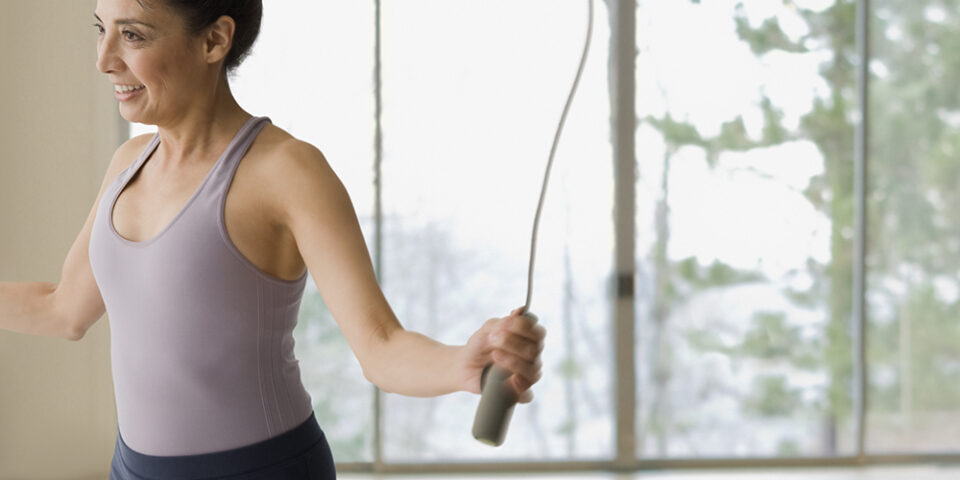What types of exercise are best for women?
While regular exercise and activity is an essential piece of living a healthier lifestyle, some wonder if the usual advice is a little too general to apply to everyone. Are there exercises that work better for men than women? What types of exercise are best for women looking to stay healthy?
OB/GYN Angela Rodi, MD, explained what types of exercise are best for women and how lack of exercise can affect overall health.
What should women focus on during exercise?
“For women, I think it comes down to ways to decrease future health risks, specifically osteoporosis, which is much more common in women,” said Dr. Rodi. “Women after menopause are at an increased risk for low bone density, which can lead to some serious problems down the line.”
Dr. Rodi noted that current data shows that a combination of weight-bearing exercises and resistance training helps to increase peak bone density if started young. Even for those who begin exercising later in life, weight-bearing and resistance training exercises help decrease future osteoporosis risks and lower the rate of fractures in the future.
What kinds of exercises are weight-bearing? What is resistance training?
A weight-bearing exercises can be as simple as jumping rope, using step boxes … even something as simple as walking or running! The idea of weight-bearing exercise is that it’s a form of activity that makes you work against gravity to accomplish your goal.
Anything that utilizes your bones to support you as you work out can help to develop bone strength.
Resistance training, on the other hand, focuses on improving overall strength and endurance. Usually, people think of lifting weights when they think of resistance training exercises. Isometrics (such as planks or leg-lifting), plyometrics (such as a squat jump) and bodyweight exercises (like a reverse crunch) all fall within the resistance training category.
The earlier you start, the better – but regardless of age, the best time to start pursuing a supportive exercise routine is now.
Do women need to use special exercise equipment to get the most benefit?
“One thing about these exercises that focus on building up your bone strength is that you really don’t need any special equipment at all,” said Dr. Rodi. “Even taking two stairs at a time can help add a little more bone-building exercise to your day. Squats, lunges, wall sits, planks … many bodyweight exercises don’t need any equipment at all and are easy to fit into your busy day.”
Should women get a gym membership for exercising?
“Not necessarily,” said Dr. Rodi. “Of course, if you get a lot of benefit from working out in a gym environment, and many do, it’s a great option! Gyms tend to have lots of equipment available and a supportive environment where multiple people are exercising at once. However, gym memberships aren’t your only option by far.”
Dr. Rodi noted that in South Carolina, an abundance of beautiful outdoor environments offer plenty of opportunities for ‘exercise in disguise.’ A walk along a nearby trail, around a lake or just down the sidewalk may be more your style and something you’re more likely to be consistent about. Prisma Health even offers MoveWell workout videos, with effective exercise routines that can be done right from the comfort of home or the office.
With multiple state parks and nearby national parks, hiking up in the mountains may be a fun way to get outside, too. Many smaller state parks or mountain areas have trails designed for inexperienced, moderate experienced, and experienced hikers, so you can enjoy the landscape without pushing too hard too soon.
What is most important when it comes to exercise?
Dr. Rodi noted that the most important thing is simply to add activity into your day consistently wherever you can. The CDC recommends between 150–300 minutes of exercise a week, or about 20 minutes a day.
However, any amount of exercise helps, and if you are able to take a quick 10-minute walk during your workday or take the stairs instead of the elevator, that will still help you add in that extra activity and benefit your body just that much more.
What matters most, Dr. Rodi said, is that you try to be at least a little active every day.
Is there a connection between lack of exercise and increased health problems?
“Absolutely,” said Dr. Rodi. “Sitting down all day can really harm your health in the long term, and most of us just aren’t active enough. There’s an increase in risk for obesity, diabetes, cardiovascular disease and blood clots in those who live a sedentary lifestyle.”
Even if you work at an office or a desk job, take time every hour or so to get up and walk away from the desk for a few minutes. Even if it’s just to go up one flight of stairs and come back down again, walk from one side of the building to the other and back, or doing a quick circle around the office. There are some workplace exercises you can perform even while sitting or standing at your desk.
Can you still exercise if you have a bad knee or hip pain?
“When you have a pre-existing injury or medical condition that makes high-impact exercises like running too painful, focus on those that take the weight and pressure off the affected joints,” said Dr. Rodi. “Swimming is a really popular form of aerobic exercise that is easier on inflamed or injured joints. Yoga and stretching can strengthen your muscles and help prevent injuries or keep them from getting worse. A stationary bike or riding a bicycle on a nearby trail may be a great option that keeps you moving while enjoying the outdoors pain-free, too!”
Find an OB/GYN provider who’s right for you
When you’re ready to grow your family, choosing the right provider is important. Learn more about our obstetricians, midwives and nurse practitioners.
Find a Provider

